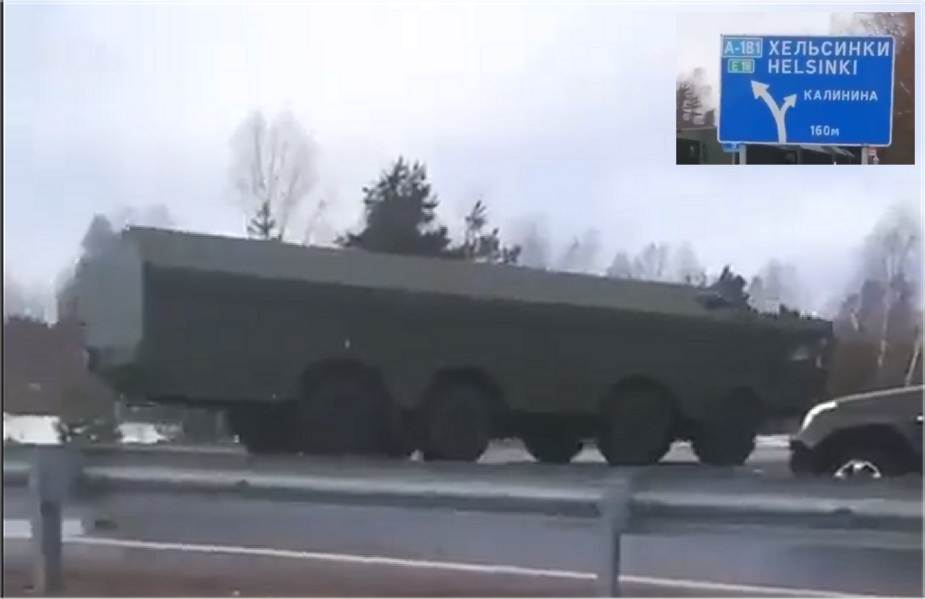Breaking news
Russian army moves missiles and heavy equipment towards Finnish border.
According to Walter Finch in the Daily Mail, Russian heavy weapons including missile systems have been seen moving towards the border with Finland, hours after the Kremlin warned its northern neighbor against joining NATO.
Follow Army Recognition on Google News at this link

The Russian army is moving missiles and heavy equipment toward Finland, in Karelia (Print Screen video Twitter account Corto Maltese)
An unconfirmed video appears to show two Russian coastal defense missile systems moving along a road on the Russian side of the border that leads to Helsinki. The missile systems, which were seen driving past a sign to the Finnish capital, are thought to be the K-300P Bastion-P mobile coastal defense system, designed to take out surface ships up to and including aircraft carrier battle groups, Walter Finch writes.
The Russian deployment comes as Finnish Prime Minister Sanna Marin said she expects her government 'will end the discussion before midsummer' on whether to apply for NATO membership. Recent opinions polls by a Finnish market research company put 84% of Finns as viewing Russia as a 'significant military threat', up by 25% from last year, Walter Finch reports.
In response, Kremlin spokesperson Dmitry Peskov euphemistically warned the move would 'not improve' the security situation in Europe, and Moscow lawmaker Vladimir Dzhabarov added more bluntly it would mean 'the destruction of the country': 'We have repeatedly said that the alliance remains a tool geared towards confrontation and its further expansion will not bring stability to the European continent,' Peskov said.
Russian army deploys in Karelia
The area in which Russian military equipment is apparently being deployed is Karelia. What is the history of this northern region bordering Finland?
The Treaty of Nystad (Finnish: Uudenkaupungin rauha) in 1721 between Imperial Russia and Sweden ceded most of Karelia to Russia. The Treaty of Åbo in 1743 between Sweden and Russia then ceded South Karelia to Russia. After Finland had been occupied by Russia in the Finnish War, parts of the ceded provinces (Old Finland) were incorporated into the Grand Duchy of Finland. In 1917, Finland became independent and the border was confirmed by the Treaty of Tartu in 1920.
Finnish partisans were involved in attempts to overthrow the Bolsheviks in Russian Karelia (East Karelia) in 1918–21, as in the failed Aunus expedition. They also wanted to re-incorporate the rest of Karelia into Finland to restore the historic border and cooperated with the short-lived Republic of Uhtua. These mainly private expeditions ended after the signing of the Treaty of Tartu. After the end of the Russian Civil War and the establishment of the Soviet Union in 1922, the Russian part of Karelia became the Karelian Autonomous republic of the Soviet Union (ASSR) in 1923.
The Molotov–Ribbentrop Pact was a non-aggression pact between Nazi Germany and the Soviet Union that enabled those two powers to partition Poland between them. The pact was signed in Moscow on 23 August 1939 by German Foreign Minister Joachim von Ribbentrop and Soviet Foreign Minister Vyacheslav Molotov and was officially known as the Treaty of Non-Aggression between Germany and the Union of Soviet Socialist Republics. Unofficially, it has also been referred to as the Hitler–Stalin Pact, Nazi–Soviet Pact or Nazi–Soviet Alliance. Germany then invaded Poland on 1 September 1939, followed on 17 September by the USSR in view of occupying the territory agreed with Hitler. This marked the beginning of World War 2.
But Stalin did not trust Hitler and wanted to create a ’’shield’’ between the USSR and Finland to prevent a German attack against Leningrad (Saint-Petersburg) throughout Finland. Obtained by exerting a threatening pressure, the Treaty of Moscow, signed in 1940, handed a large portion of Finnish Karelia to the Soviet Union, and over 400,000 people had to be relocated within Finland. During the Continuation War, between 1941 and 1944, the Finns recuperated much of East Karelia for three years. After World War 2, Soviet expansion caused considerable bitterness in Finland, which lost its fourth biggest city, Viipuri, its industrial heartland along the river Vuoksi, the Saimaa canal that connected central Finland to the Gulf of Finland, and access to the fishing waters of Lake Ladoga (Finnish: Laatokka). One-eighth of its citizens became refugees with no chance of return. The whole population from the areas ceded to the Soviet Union was evacuated and resettled in other parts of Finland. The present inhabitants of the former Finnish parts of Russia, including the city of Vyborg/Viipuri and the Karelian Isthmus – are post-war immigrants or their descendants.
The former Karelian ASSR was incorporated into a new Karelo-Finnish SSR from 1941 to 1956, but then it became an ASSR again. Karelia was the only Soviet republic that was "demoted" from an SSR to an ASSR within the Russian SFSR. Unlike administrative republics, Soviet republics (in theory) had the constitutional right to secede. Fear of secession, as well as the Russian ethnic minority in Karelia, may have resulted in its "demotion".
In 1991, with the collapse of the Soviet Union, the ASSR became the Republic of Karelia. The political collapse brought about an economic collapse and the Republic has experienced massive urban decay. The buildings hastily and poorly constructed during the Soviet era, as well as older houses remaining from the Finnish era, are being abandoned.



















